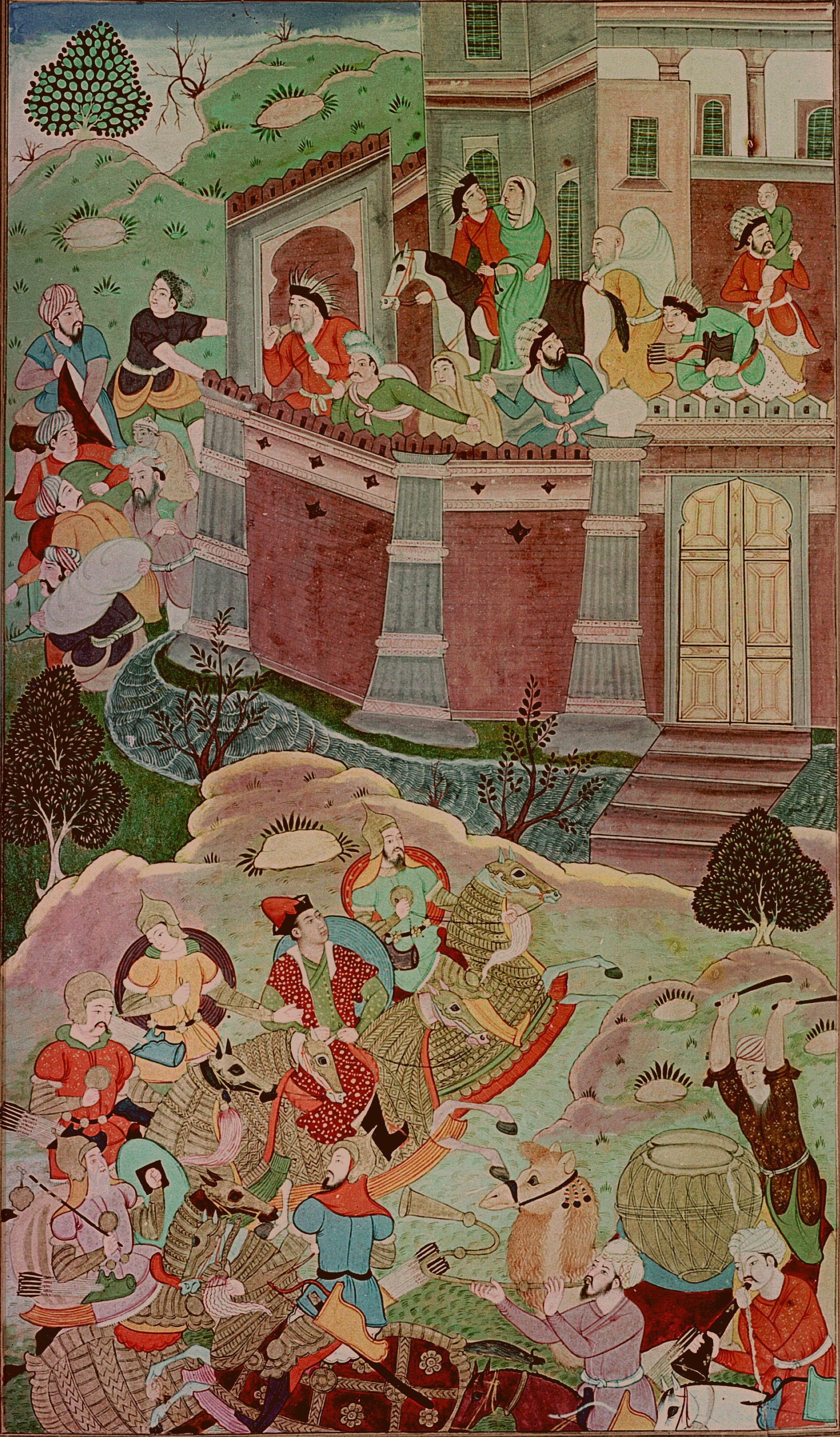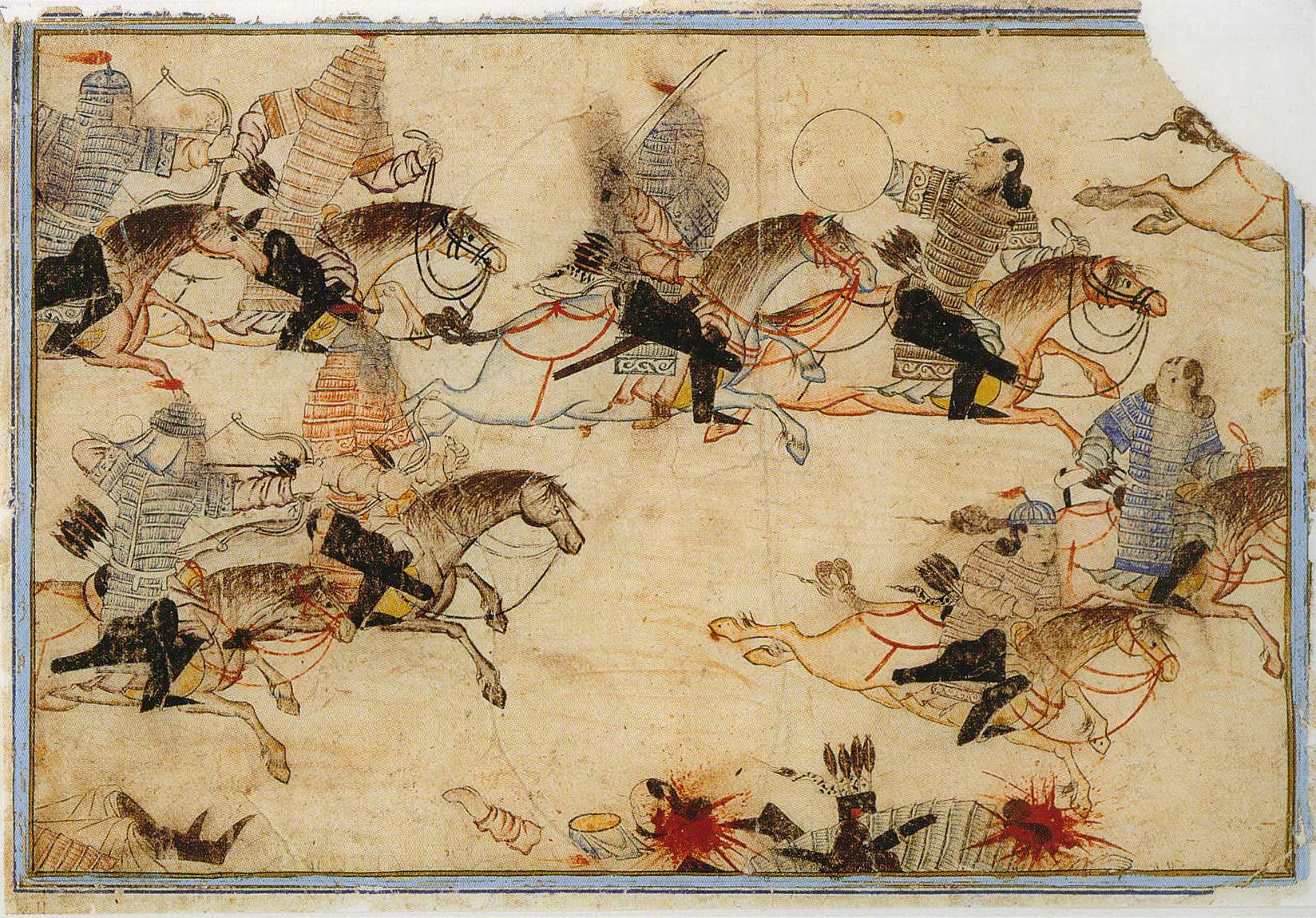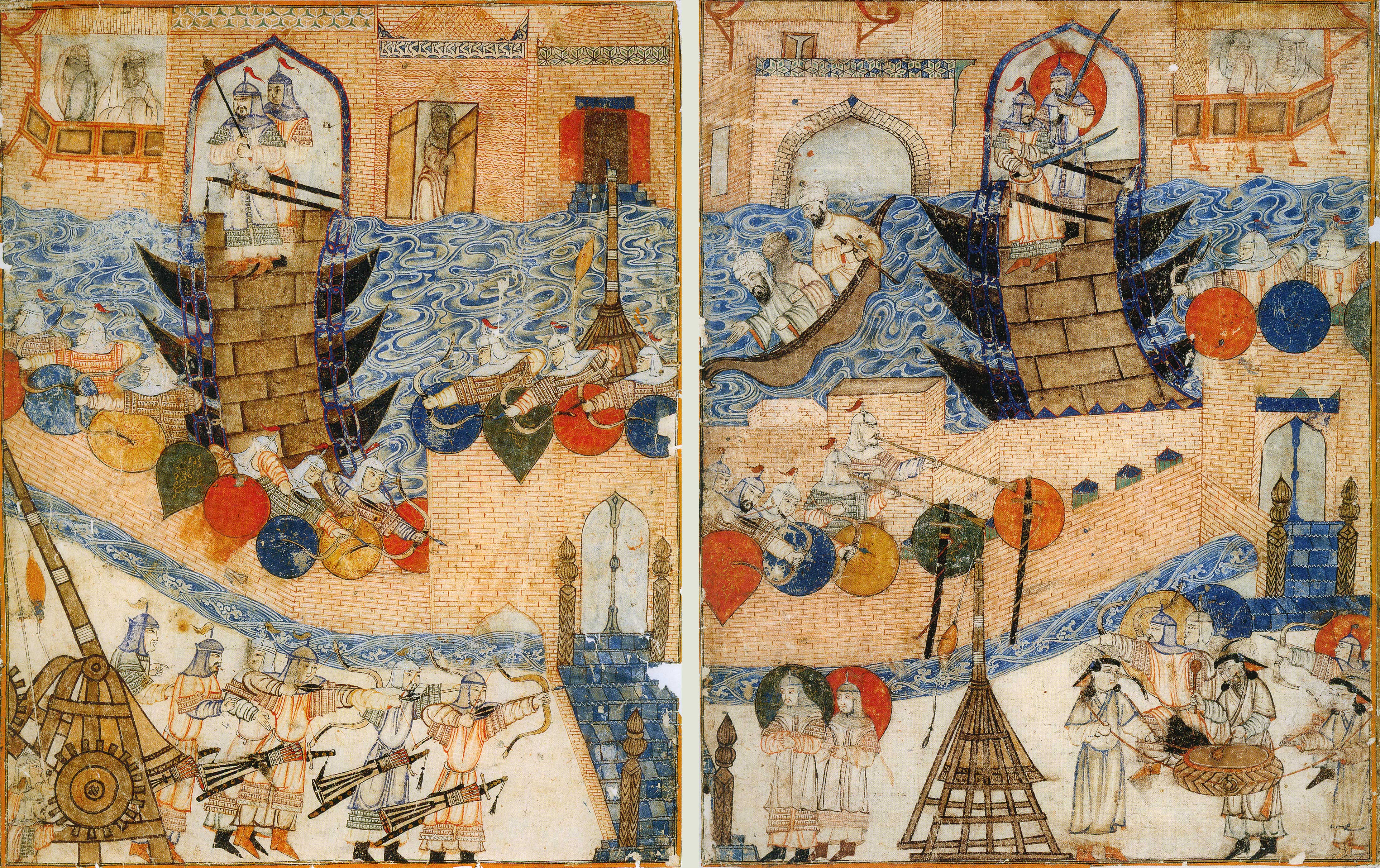|
Toluid Civil War
The Toluid Civil War was a war of succession fought between Kublai Khan and his younger brother, Ariq Böke, from 1260 to 1264. Möngke Khan died in 1259 with no declared successor, precipitating infighting between members of the Tolui family line for the title of Great Khan that escalated to a civil war. The Toluid Civil War, and the wars that followed it (such as the Berke–Hulagu war and the Kaidu–Kublai war), weakened the authority of the Great Khan over the Mongol Empire and split the empire into autonomous khanates. Background The Tolui family successfully enthroned their candidate for Great Khan, Möngke, in the kurultais of 1250 and 1251. The Ögedeid candidate for Great Khan, Shiremun, and his cousin Nakhu, were embittered by their loss and plotted a failed assassination of Möngke. Möngke took revenge by purging his opponents in the royal house, and members of both the Chagatai and Ögedei families. Möngke handed control over the Caucasus region to the Gol ... [...More Info...] [...Related Items...] OR: [Wikipedia] [Google] [Baidu] |
Division Of The Mongol Empire
The division of the Mongol Empire began when Möngke Khan died in 1259 in the siege of Diaoyu Castle with no declared successor, precipitating infighting between members of the Tolui family line for the title of khagan that escalated into the Toluid Civil War. This civil war, along with the Berke–Hulagu war and the subsequent Kaidu–Kublai war, greatly weakened the authority of the great khan over the entirety of the Mongol Empire, and the empire fractured into four khanates: the Golden Horde in Eastern Europe, the Chagatai Khanate in Central Asia, the Ilkhanate in Southwest Asia, and the Yuan dynasty in East Asia based in modern-day Beijing – although the Yuan emperors held the nominal title of khagan of the empire. The four divisions each pursued their own interests and objectives and fell at different times. Dispute over succession Möngke Khan's brother Hulagu Khan broke off his successful military advance into Syria, withdrawing the bulk of his forces to Mughan and ... [...More Info...] [...Related Items...] OR: [Wikipedia] [Google] [Baidu] |
Civil War
A civil war or intrastate war is a war between organized groups within the same state (or country). The aim of one side may be to take control of the country or a region, to achieve independence for a region, or to change government policies. James Fearon"Iraq's Civil War" in '' Foreign Affairs'', March/April 2007. For further discussion on civil war classification, see the section "Formal classification". The term is a calque of Latin '' bellum civile'' which was used to refer to the various civil wars of the Roman Republic in the 1st century BC. Most modern civil wars involve intervention by outside powers. According to Patrick M. Regan in his book ''Civil Wars and Foreign Powers'' (2000) about two thirds of the 138 intrastate conflicts between the end of World War II and 2000 saw international intervention, with the United States intervening in 35 of these conflicts. A civil war is a high-intensity conflict, often involving regular armed forces, that is sustained, ... [...More Info...] [...Related Items...] OR: [Wikipedia] [Google] [Baidu] |
Shangdu
Shangdu (, ), also known as Xanadu (; Mongolian: ''Šandu''), was the summer capital of the Yuan dynasty of China before Kublai decided to move his throne to the former Jin dynasty capital of Zhōngdū () which was renamed Khanbaliq ( present-day Beijing). Shangdu is located in the present-day Zhenglan Banner, Inner Mongolia. In June 2012, it was made a World Heritage Site for its historical importance and for the unique blending of Mongolian and Chinese culture. Venetian traveller Marco Polo described Shangdu to Europeans after visiting it in 1275. It was conquered in 1369 by the Ming dynasty army under the Hongwu Emperor. In 1797, historical accounts of the city inspired the famous poem ''Kubla Khan'' by the English Romantic poet Samuel Taylor Coleridge. Descriptions Shangdu was located in what is now Shangdu Town, Zhenglan Banner, Inner Mongolia, north of Beijing. It is about northwest of the modern town of Duolun. The layout of the capital is roughly square s ... [...More Info...] [...Related Items...] OR: [Wikipedia] [Google] [Baidu] |
Song Dynasty
The Song dynasty (; ; 960–1279) was an imperial dynasty of China that began in 960 and lasted until 1279. The dynasty was founded by Emperor Taizu of Song following his usurpation of the throne of the Later Zhou. The Song conquered the rest of the Ten Kingdoms, ending the Five Dynasties and Ten Kingdoms period. The Song often came into conflict with the contemporaneous Liao, Western Xia and Jin dynasties in northern China. After retreating to southern China, the Song was eventually conquered by the Mongol-led Yuan dynasty. The dynasty is divided into two periods: Northern Song and Southern Song. During the Northern Song (; 960–1127), the capital was in the northern city of Bianjing (now Kaifeng) and the dynasty controlled most of what is now Eastern China. The Southern Song (; 1127–1279) refers to the period after the Song lost control of its northern half to the Jurchen-led Jin dynasty in the Jin–Song Wars. At that time, the Song court retreated south of ... [...More Info...] [...Related Items...] OR: [Wikipedia] [Google] [Baidu] |
Karakorum
Karakorum ( Khalkha Mongolian: Хархорум, ''Kharkhorum''; Mongolian Script:, ''Qaraqorum''; ) was the capital of the Mongol Empire between 1235 and 1260 and of the Northern Yuan dynasty in the 14–15th centuries. Its ruins lie in the northwestern corner of the Övörkhangai Province of modern-day Mongolia, near today's town of Kharkhorin and adjacent to the Erdene Zuu Monastery, the probably earliest surviving Buddhist monastery in Mongolia. They are part of the upper part of the World Heritage Site Orkhon Valley. History Foundation of empires The Orkhon valley was a center of the Xiongnu, Göktürk, and Uyghur empires. To the Göktürks, the nearby Khangai Mountains had been the location of the Ötüken (the locus of power), and the Uyghur capital Karabalgasun was located close to where later Karakorum would be erected (downstream the Orkhon River 27 km north–west from Karakorum). This area is probably also one of the oldest farming areas in ... [...More Info...] [...Related Items...] OR: [Wikipedia] [Google] [Baidu] |
Siege Of Baghdad (1258)
The siege of Baghdad was a siege that took place in Baghdad in 1258, lasting for 13 days from January 29, 1258 until February 10, 1258. The siege, laid by Ilkhanate Mongol forces and allied troops, involved the investment, capture, and sack of Baghdad, which was the capital of the Abbasid Caliphate at that time. The Mongols were under the command of Hulagu Khan, brother of the khagan Möngke Khan, who had intended to further extend his rule into Mesopotamia but not to directly overthrow the Caliphate. Möngke, however, had instructed Hulagu to attack Baghdad if the Caliph Al-Musta'sim refused Mongol demands for his continued submission to the khagan and the payment of tribute in the form of military support for Mongol forces in Persia. Hulagu began his campaign in Persia against the strongholds of Nizari Ismailis, who lost their stronghold of Alamut. He then marched on Baghdad, demanding that Al-Musta'sim accede to the terms imposed by Möngke on the Abbasids. Altho ... [...More Info...] [...Related Items...] OR: [Wikipedia] [Google] [Baidu] |
Hulagu Khan
Hulagu Khan, also known as Hülegü or Hulegu ( mn, Хүлэгү/ , lit=Surplus, translit=Hu’legu’/Qülegü; chg, ; Arabic: fa, هولاکو خان, ''Holâku Khân;'' ; 8 February 1265), was a Mongol ruler who conquered much of Western Asia. Son of Tolui and the Keraite princess Sorghaghtani Beki, he was a grandson of Genghis Khan and brother of Ariq Böke, Möngke Khan, and Kublai Khan. Hulagu's army greatly expanded the southwestern portion of the Mongol Empire, founding the Ilkhanate of Persia, a precursor to the eventual Safavid dynasty, and then the modern state of Iran. Under Hulagu's leadership, the siege of Baghdad (1258) destroyed Baghdad's standing in the Islamic Golden Age and weakened Damascus, causing a shift of Islamic influence to the Mamluk Sultanate in Cairo and ended the Abbasid Dynasty. Background Hulagu was born to Tolui, one of Genghis Khan's sons, and Sorghaghtani Beki, an influential Keraite princess and a niece of Tog ... [...More Info...] [...Related Items...] OR: [Wikipedia] [Google] [Baidu] |
Rus' (region)
Ruthenia or , uk, Рутенія, translit=Rutenia or uk, Русь, translit=Rus, label=none, pl, Ruś, be, Рутэнія, Русь, russian: Рутения, Русь is an exonym, originally used in Medieval Latin as one of several terms for Kievan Rus', the Kingdom of Galicia-Volhynia and, after their collapse, for East Slavic and Eastern Orthodox regions of the Grand Duchy of Lithuania and the Kingdom of Poland, corresponding to what is now Ukraine and Belarus. During the early modern period, the term ''Ruthenia'' started to be mostly associated with the Ruthenian lands of the Polish Crown and the Cossack Hetmanate. Bohdan Khmelnytsky declared himself the ruler of ''the Ruthenian state'' to the Polish representative Adam Kysil in February 1649. Grand Principality of Ruthenia was the project name of the Cossack Hetmanate integrated into the Polish–Lithuanian–Ruthenian Commonwealth. Lands inhabited by Ukrainians (Ruthenians) of the Kingdom of Galicia and L ... [...More Info...] [...Related Items...] OR: [Wikipedia] [Google] [Baidu] |
Batu Khan
Batu Khan ( – 1255),, ''Bat haan'', tt-Cyrl, Бату хан; ; russian: хан Баты́й was a Mongol ruler and founder of the Golden Horde, a constituent of the Mongol Empire. Batu was a son of Jochi, thus a grandson of Genghis Khan. His ''ulus'' ruled over the Kievan Rus', Volga Bulgaria, Cumania, and the Caucasus for around 250 years. Personality and appearance According to Giovanni da Pian del Carpine, Batu was "kind enough to his own people, but he is greatly feared by them. He is, however, most cruel in fight; he is very shrewd and extremely crafty in warfare, for he has been waging war for a long time." William of Rubruck described him as about the height of his lord John de Beaumont and his entire face was covered with reddish spots. Early years After his son Jochi's death, Genghis Khan assigned Jochi's appanages to his sons. The Great Khan installed Batu as Khan of the Golden Horde (also known as the Ulus of Jochi or Kipchak Khanate). Jochi's e ... [...More Info...] [...Related Items...] OR: [Wikipedia] [Google] [Baidu] |
Golden Horde
The Golden Horde, self-designated as Ulug Ulus, 'Great State' in Turkic, was originally a Mongol and later Turkicized khanate established in the 13th century and originating as the northwestern sector of the Mongol Empire. With the fragmentation of the Mongol Empire after 1259 it became a functionally separate khanate. It is also known as the Kipchak Khanate or as the Ulus of Jochi, and replaced the earlier less organized Cuman–Kipchak confederation. After the death of Batu Khan (the founder of the Golden Horde) in 1255, his dynasty flourished for a full century, until 1359, though the intrigues of Nogai instigated a partial civil war in the late 1290s. The Horde's military power peaked during the reign of Uzbeg Khan (1312–1341), who adopted Islam. The territory of the Golden Horde at its peak extended from Siberia and Central Asia to parts of Eastern Europe from the Urals to the Danube in the west, and from the Black Sea to the Caspian Sea in the south, while ... [...More Info...] [...Related Items...] OR: [Wikipedia] [Google] [Baidu] |
Caucasus
The Caucasus () or Caucasia (), is a region between the Black Sea and the Caspian Sea, mainly comprising Armenia, Azerbaijan, Georgia, and parts of Southern Russia. The Caucasus Mountains, including the Greater Caucasus range, have historically been considered as a natural barrier between Eastern Europe and Western Asia. Mount Elbrus in Russia, Europe's highest mountain, is situated in the Western Caucasus. On the southern side, the Lesser Caucasus includes the Javakheti Plateau and the Armenian highlands, part of which is in Turkey. The Caucasus is divided into the North Caucasus and South Caucasus, although the Western Caucasus also exists as a distinct geographic space within the North Caucasus. The Greater Caucasus mountain range in the north is mostly shared by Russia and Georgia as well as the northernmost parts of Azerbaijan. The Lesser Caucasus mountain range in the south is occupied by several independent states, mostly by Armenia, Azerbaijan, and Georgia, but ... [...More Info...] [...Related Items...] OR: [Wikipedia] [Google] [Baidu] |
Chagatai Khan
Chagatai Khan ( Mongolian: ''; Čaɣatay''; mn, Цагадай, translit=Tsagadai; chg, , ''Čaġatāy''; ug, چاغاتاي خان, ''Chaghatay-Xan''; zh, 察合台, ''Chágětái''; fa, , ''Joghatây''; 22 December 1183 – 1 July 1242) was the second son of Genghis Khan and Börte. He inherited most of what are now five Central Asian states after the death of his father. He was also appointed by Genghis Khan to oversee the execution of the Yassa, the written code of law created by Genghis Khan. Under Genghis Khan Very little is known about Chagatai's earlier life. He was the second son of Genghis Khan and Börte. Chagatai was considered hot-headed and somewhat temperamental by his relatives, because of his attitude of non-acceptance of Jochi as a full-brother. He was the most vocal about this issue among his relations. He was assigned 4 mingghans (led by Qarachar of Barlas, Kököchü of Baarin, Müge of Jalairs and Idiqudai Noyan) and an appanage around Al ... [...More Info...] [...Related Items...] OR: [Wikipedia] [Google] [Baidu] |


.jpg)



.jpeg/1200px-Prise_d'Alamût_(1256).jpeg)


